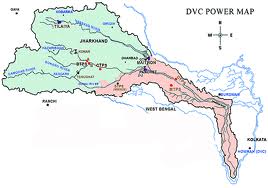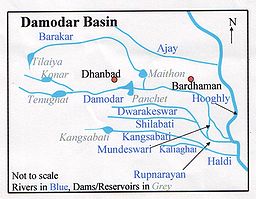Damodar River
 The Damodar River rises at the Chandwa village, Palamau hills of Choota Nagpur in the Jharkhand state . It flows in a south-easterly direction entering the deltaic plains below Raniganj. Near Burdwan, the river abruptly changes its course to a southerly direction and joins Hooghly about 48.27 km below Calcutta. Damodar basin lies in the states of Jharkhand and West Bengal.The Chota Nagpur Plateau receives an average annual rainfall of around 1400 mm, almost all of it in the monsoon months between June and August. Damodar River was earlier known as the River of Sorrows as it used to flood many areas of Bardhaman, Hughli, Howrah and Medinipur districts.
The Damodar River rises at the Chandwa village, Palamau hills of Choota Nagpur in the Jharkhand state . It flows in a south-easterly direction entering the deltaic plains below Raniganj. Near Burdwan, the river abruptly changes its course to a southerly direction and joins Hooghly about 48.27 km below Calcutta. Damodar basin lies in the states of Jharkhand and West Bengal.The Chota Nagpur Plateau receives an average annual rainfall of around 1400 mm, almost all of it in the monsoon months between June and August. Damodar River was earlier known as the River of Sorrows as it used to flood many areas of Bardhaman, Hughli, Howrah and Medinipur districts.
Damodar Valley
 The Damodar Valley lies in the Chota Nagpur Plateau of the state of Jharkhand, India. It also extends to some parts of the state of West Bengal. The Damodar Valley is one of the most industrialised parts of India. Three integrated steel plants (Bokaro, Burnpur and Durgapur) of Steel Authority of India Limited (SAIL) and other factories are located in the valley.The Damodar Valley contains large reserves of coal and mica, and the area is a highly developed industrial belt. Many refer to the Damodar Valley as the Ruhr of India because of its similarities with the Ruhr mining-industrial area of Germany. The dams on the Damodar River have several hydroelectric power plants. Of late, the Damodar has become one of the most polluted rivers of India, with chemicals, mine rejects and toxic effluents flowing into the river from mines and industries located in the valley.The largest (almost the only) reserves of coking coal in the country are found in the Jharia coalfields in the valley. The valley also generates 60% of India’s medium grade coal. Coal India Limited operates in the valley in a big way. Several dams have been constructed in the valley, for the generation of hydroelectric power.
The Damodar Valley lies in the Chota Nagpur Plateau of the state of Jharkhand, India. It also extends to some parts of the state of West Bengal. The Damodar Valley is one of the most industrialised parts of India. Three integrated steel plants (Bokaro, Burnpur and Durgapur) of Steel Authority of India Limited (SAIL) and other factories are located in the valley.The Damodar Valley contains large reserves of coal and mica, and the area is a highly developed industrial belt. Many refer to the Damodar Valley as the Ruhr of India because of its similarities with the Ruhr mining-industrial area of Germany. The dams on the Damodar River have several hydroelectric power plants. Of late, the Damodar has become one of the most polluted rivers of India, with chemicals, mine rejects and toxic effluents flowing into the river from mines and industries located in the valley.The largest (almost the only) reserves of coking coal in the country are found in the Jharia coalfields in the valley. The valley also generates 60% of India’s medium grade coal. Coal India Limited operates in the valley in a big way. Several dams have been constructed in the valley, for the generation of hydroelectric power.
Damodar Valley Corporation
Damodar Valley Corporation, popularly known as DVC, came into being on July 7, 1948 by an Act of the Constituent Assembly of India (Act No. XIV of 1948) as the first multipurpose river valley project of independent India. It is modelled on the Tennessee Valley Authority of the USA.The first dam was built across the Barakar River, a tributary of the Damodar river at Tilaiya in 1953. The second one was built across the Konar River, another tributary of the Damodar river at Konar in 1955. Two dams across the rivers Barakar and Damodar were built at Maithon in 1957 and Panchet in 1959. Both the dams are some 8 km upstream of the confluence point of the rivers. These four major dams are controlled by DVC. In 1978, the Government of Bihar (that was before the formation of the state of Jharkhand) constructed the Tenughat Dam across the Damodar river outside the control of DVC
Latest News on Damodar and DVC
June 17,2011 : Union Cabinet approved introduction of Damodar Valley Croporation (Amendment) Bill 2011
- In order to broad-base and infuse professionalism in the working of Damodar Valley Croporation (DVC), the Union Cabinet on Thursday gave its nod for the introduction of the Damodar Valley Croporation (Amendment) Bill, 2011, in Parliament. The Bill seeks reconstitution of the corporation with four full-time members, namely chairman, member (technical), member (finance) and member secretary, and six part-time members. According to the Cabinet’s decision, now the chairman will be the CEO of the corporation while the posts of financial adviser and secretary have been abolished.
Reference : wikipedia





0 comments: